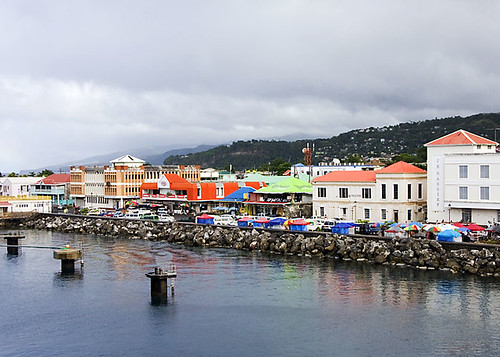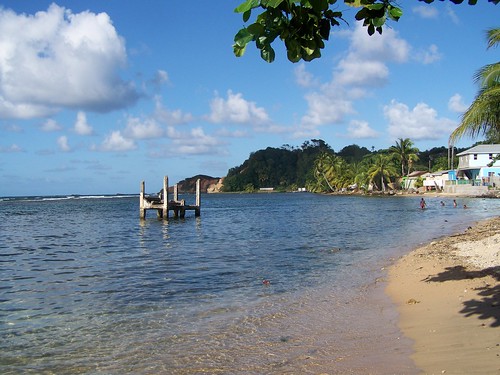
Roseau, Dominica by Olga Melhiser
Dominica, (French: Dominique) officially the Commonwealth of Dominica, is an island nation in the Caribbean Sea. To the north-northwest lies Guadeloupe, to the southeast Martinique. Its size is 754 square kilometres (291 sq mi) and the highest point in the country is Morne Diablotins, which has an elevation of 1,447 metres (4,750 ft). The Commonwealth of Dominica has an estimated population of 72,500. The capital is Roseau.

A Pair of Ecuadorian Amazon Red-Lored Parrots by Crispin Swan
Dominica has been nicknamed the "Nature Isle of the Caribbean" for its seemingly unspoiled natural beauty. It is the youngest island in the Lesser Antilles, still being formed by geothermal-volcanic activity, as evidenced by the world's second-largest boiling lake.
The island features lush mountainous rainforests, home of many very rare plant, animal, and bird species. There are xeric areas in some of the western coastal regions, but heavy rainfall can be expected inland. The Sisserou parrot, the island's national bird, is featured on the national flag. Dominica's economy is heavily dependent on both tourism and agriculture.
The island features lush mountainous rainforests, home of many very rare plant, animal, and bird species. There are xeric areas in some of the western coastal regions, but heavy rainfall can be expected inland. The Sisserou parrot, the island's national bird, is featured on the national flag. Dominica's economy is heavily dependent on both tourism and agriculture.

Trafalgar Falls by globaltraveller
Dominica is largely awninged by rainforest and is home to the world's second-largest boiling lake. state has many waterfalls, springs, and rivers. The Calibishie area in the country's northeast has blonde beaches. Some plants and animals thought to be nonexistent on surrounding islands can ease be institute in Dominica's forests. The volcanic nature of the island has attracted scuba divers. The island has several protected areas, including Cabrits National Park. state has 365 rivers.
Morne Trois Pitons National Park is a tropical forest blended with scenic volcanic features. It was recognized as a World Heritage Site on April 4, 1995, a secernment it shares with four other sea islands.
Morne Trois Pitons National Park is a tropical forest blended with scenic volcanic features. It was recognized as a World Heritage Site on April 4, 1995, a secernment it shares with four other sea islands.

Roseau, Dominica, The Caribbean by DMF Photography
The Caribbean Sea offshore of the island of Dominica is home to many cetaceans. Most notably a group of sperm whales live in this area year round. Other cetaceans commonly seen in the area include spinner dolphins, pantropical spotted dolphins and bottlenose dolphins. Less commonly seen animals include killer whales, false killer whales, pygmy sperm whales, dwarf sperm whales, Risso's dolphins, common dolphins, Atlantic spotted dolphins, humpback whales and Bryde's whales. This makes Dominica a destination for tourists interested in whale-watching.

Roseau, Dominica by Jasperdo
There are two diminutive airports on the island. The primary airport, Melville Hall Airport (DOM), is on the north coast and is about a 45-minute drive from Portsmouth. The second is Canefield Airport (DCF), about 15 minutes from Roseau on the south coast. Neither airport is suitable for advertizement jets cod to runway length, demand of runway lights, and demand of helper landing system, but Melville Hall currently has regular assist by American Eagle and LIAT using twin aeroplane aircraft same the De Havilland Dash 8. A runway spreading and assist raise send began at Melville Hall around 2006 and is still in advancement as of early 2009.

Dominica Street Musician by Serena_DeAzul 007
Music and dance are important facets of Dominica's culture. The annual independence celebrations show an outburst of traditional strain and dance preceded since 1997 by weeks of Creole expressions such as \"Creole in the Park\" and the \"World Creole Music Festival\". Dominica gained prominence on the international penalization initiate when in 1973, Gordon Henderson founded the group Exile One and an original musical genre which he coined \"Cadence-lypso\" which paved the way for modern Creole music.

Calibishie village beach by OpenEnglishWeb
Dominican cuisine is similar to that of other Caribbean countries. Common main courses comprise of meat (usually chicken, but can be goat, lamb, or beef) covered in sauce. the sauces are either spicy pepper sauces, or concoctions made from local fruit. A huge variety of local fruit, from tamarind to passion fruit, are served on the island, usually in juice or sauce form. Soursop is peeled and eaten raw. Sorrel, a red flower that only blooms around Christmas, is boiled into a bright red drink.
No comments:
Post a Comment